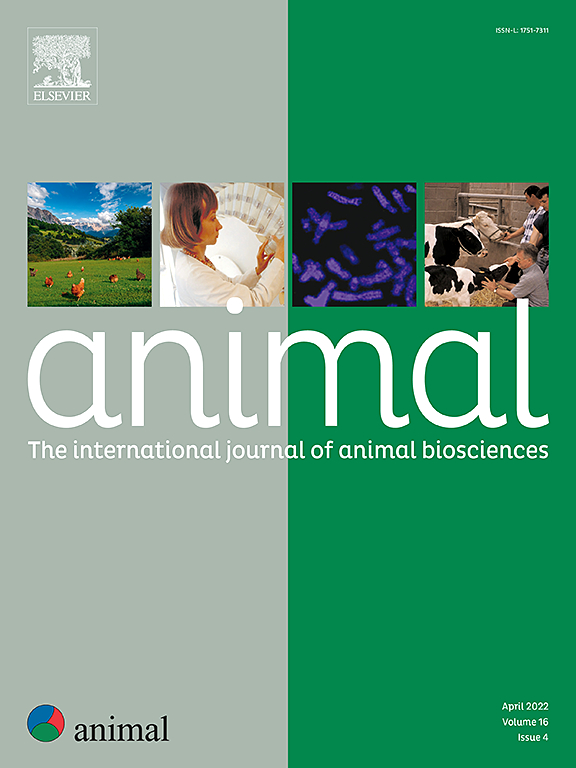山地虚拟围栏的有效性及其对小母牛行为和福利的影响
IF 4.2
2区 农林科学
Q1 AGRICULTURE, DAIRY & ANIMAL SCIENCE
引用次数: 0
摘要
虚拟围栏(VF)在电线围栏困难且耗时的山区可能是有益的。然而,山地牧场的环境挑战可能会损害VF的功效和功能,对动物的行为和福利产生潜在影响。30头雌性小母牛配备了活动传感器和VF项圈来记录活动行为、VF音频音调(ATs)和电脉冲(EPs)。在低地进行VF训练后,这些小母牛被转移到瑞士的夏季牧场。山地场地被划分为9个围场,其中3个围场仅用电线围起来(仅用ef处理),另外6个围场使用了VF (VF处理)。在山上放牧时,牛群被分成三组,每组10头小母牛。所有组同时在单独的围场放牧,并在一个轮牧系统中依次穿过9个围场。摄像机记录了动物在虚拟围栏接触时的反应。测量草高以估计目前放牧围场的牧草可用性。使用混合效应模型分析数据。从活动数据中,我们还计算了功能耦合度(DFC),这是一种用于检查昼夜活动节律作为长期动物福利指标的度量,范围从0(差)到1(福利良好)。在整个放牧过程中,我们记录了36只动物在11次穿越电围栏的事件中逃脱,17只动物在8次与VF有关的事件中逃脱。小母牛平均(±SD)日产量为5.9±8.2 ATs和0.3±0.8 EPs。在草高较低(P≤0.004)和发生意外事件(P≤0.001)的日子,如遇到野生动物或邻近的牛,ATs和EPs增加。与VF训练相比,山地放牧期间与ATs相关的放牧中断时间更短(P <;0.001)。围栏类型不影响小母牛步数(P >;0.05),但VF组每日躺卧时间比单纯ef组多10 min (P = 0.001)。在两种围栏类型中,小母牛的活动模式都具有高度的节律性(DFC≥0.92),但在VF处理的7 d期间,由于围场的变化,小母牛的活动模式有所下降(P <;0.001)。综上所述,VF系统在防止逃逸事件方面与电围栏一样可靠。小母牛学会了对VF刺激做出适当的反应,即使是在充满挑战的山区。在DFC中反映的整体高活动节律性支持了长期动物福利不受VF使用的损害。本文章由计算机程序翻译,如有差异,请以英文原文为准。
Effectiveness of virtual fencing in a mountain environment and its impact on heifer behaviour and welfare
Virtual fencing (VF) could be beneficial in mountain areas where electric wire fencing is difficult and time-consuming. However, environmental challenges of mountain pastures may impair VF efficacy and functionality, with potential effects on animal behaviour and welfare. Thirty female heifers were equipped with activity sensors and VF collars to record activity behaviour, VF audio tones (ATs) and electric pulses (EPs). After VF training in the lowlands, the heifers were moved to a Swiss summer pasture. The mountain site was divided into nine paddocks, three of which were fenced with electric wire only (EF-only treatment) and six additionally used VF (VF treatment). During mountain grazing, the herd was split into three groups of 10 heifers each. All groups grazed simultaneously in separate paddocks and moved sequentially through the nine paddocks in a rotational grazing system. Video cameras recorded animal reactions upon virtual fence contact. Grass height was measured to estimate forage availability in the currently grazed paddocks. Data were analysed using mixed-effects models. From the activity data, we also calculated the Degree of Functional Coupling (DFC), a metric for examining circadian activity rhythms as an indicator of longer-term animal welfare, ranging from zero (poor) to one (good state of welfare). Throughout mountain grazing, we recorded 36 escaped animals in 11 events crossing an electric fence and 17 escaped animals in eight events linked to VF. Heifers received a mean (± SD) number of 5.9 ± 8.2 ATs and 0.3 ± 0.8 EPs per day. The ATs and EPs increased at lower grass heights (both P ≤ 0.004) and on days with unforeseen events (both P ≤ 0.001), such as encounters with wildlife or neighbouring cattle. Grazing interruptions associated with ATs were shorter during mountain grazing compared to VF training (P < 0.001). Fence type did not affect heifer step count (P > 0.05), but daily lying time was 10 min longer in the VF than EF-only treatment (P = 0.001). The heifer’s activity pattern was highly rhythmic at both fence types (DFC ≥ 0.92) but decreased during 7-d periods involving a paddock change within VF treatments (P < 0.001). In conclusion, the VF system was as reliable as electric fencing in preventing escape events. Heifers learned to respond appropriately to the VF stimuli, even in challenging mountainous terrain. An overall high activity rhythmicity reflected in the DFC supported that longer-term animal welfare was not compromised by VF use.
求助全文
通过发布文献求助,成功后即可免费获取论文全文。
去求助
来源期刊

Animal
农林科学-奶制品与动物科学
CiteScore
7.50
自引率
2.80%
发文量
246
审稿时长
3 months
期刊介绍:
Editorial board
animal attracts the best research in animal biology and animal systems from across the spectrum of the agricultural, biomedical, and environmental sciences. It is the central element in an exciting collaboration between the British Society of Animal Science (BSAS), Institut National de la Recherche Agronomique (INRA) and the European Federation of Animal Science (EAAP) and represents a merging of three scientific journals: Animal Science; Animal Research; Reproduction, Nutrition, Development. animal publishes original cutting-edge research, ''hot'' topics and horizon-scanning reviews on animal-related aspects of the life sciences at the molecular, cellular, organ, whole animal and production system levels. The main subject areas include: breeding and genetics; nutrition; physiology and functional biology of systems; behaviour, health and welfare; farming systems, environmental impact and climate change; product quality, human health and well-being. Animal models and papers dealing with the integration of research between these topics and their impact on the environment and people are particularly welcome.
 求助内容:
求助内容: 应助结果提醒方式:
应助结果提醒方式:


